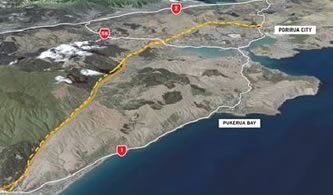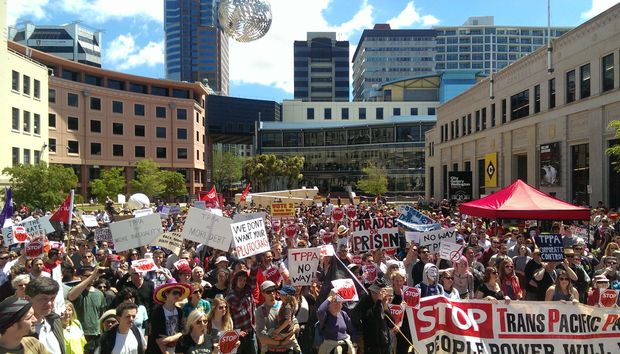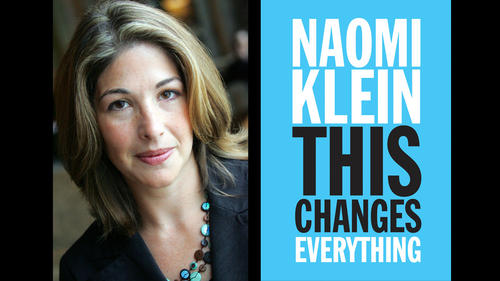The following is an article written by kiwi Joel Benjamin who is in the country for three months. Formerly from Hawkes Bay, he is currently a researcher for Goldsmith University in London and was formerly a campaigner for public finance.
 It’s time for a serious public debate on infrastructure future.
It’s time for a serious public debate on infrastructure future.
This week at the Auckland transport summit 2014, experts from around New
Zealand will gather in Auckland to discuss transport infrastructure planning
solutions to address Auckland’s growing urban transport problems.
Entirely missing from the debate however, will be an open public discussion of
how such infrastructure will be paid for by all New Zealanders, and paid to
whom?
Having recently returned to New Zealand after several years in financial
campaigning in London, I was interested to see what was being proposed in New
Zealand across the infrastructure planning and finance space. The answer is PPP.
Upon leaving a planning role with Napier City Council in 2006, I spent 3 years in
Melbourne with State transport authority VicRoads, before briefly entering the
consultancy game.
Through the experience of working on projects including the Calder Corridor and
Geelong bypass in Melbourne and Sydney West Metro underground rail, I have
seen the best and worst of what the private and public sector have to say and do
on infrastructure development.
Compared with Melbourne, Sydney is a transport infrastructure basket-case,
suffering from 20 years of State Government decision making paralysis.
While the construction companies hate the constant transport planning u-turns,
for the planning and engineering consultants, it’s a fee earning gold mine, with
taxpayer funded “team-building” gigs sailing on Sydney harbour all the rage.
Ideologically I am not wedded to either public or private sector approach to
infrastructure delivery. I am however extremely concerned about who pays for
infrastructure, and that what is designed and built is fit for purpose and meets
demonstrable public needs.
In the mid 1990’s Australia and the UK embarked on a infrastructure financing
model called the Private Finance Initiative (PFI/PPP) to fund public
infrastructure including schools, roads and hospitals “off balance sheet” using
more expensive bank finance, instead of Government borrowing.
Whilst PFI has proved a gold mine for private financiers and construction firms,
it’s been a disaster for the UK taxpayer.
To pay back £55 billion of PFI/PPP infrastructure will cost UK taxpayers £301
billion over the next 30 years.
Interest charges on PFI bank finance are at least double the cost of Government
borrowing. In the NHS, academic Allyson Pollock has stated PFI has frequently
meant “one hospital for the price of two.”
Our Prime Minister John Key spent his working life in London within a banking
environment where such profits at taxpayers expense were considered not only
desirable, but entirely normal.
With the recent creation of the Auckland “super city” and talk of local
government mergers in Hawkes Bay where I grew up, I see plenty of warning
signs that PFI/PPP super profits are occupying the thinking of politicians here,
and taxpayers have every right to be concerned.
It turns out that the modern infrastructure industry is not especially concerned
with financing development, its objective is developing finance.
The aim is to get as much private bank debt out the door as humanly possible
with unsuspecting taxpayers on the hook to pay for it.
The public utility of any planned infrastructure (if it is even needed) is of
secondary concern to authorities, whose job is to maximise private profits.
Planned Public-Private (PPP) infrastructure projects including the Ruataniwha
Dam in Hawkes Bay, and Transmission Gully in Wellington should be considered
and scrutinised in this light. Coincidentally, both PPP projects which are financed
by BNZ.
The “vertical integration” or alignment of commercial interest between the
infrastructure developers and the bank is so complete that Andrew Pearce, the
Chairman of HBRICL who are developing the Ruataniwha Dam project also sits
on the BNZ board.
There is no accusation of impropriety involved, but taxpayers should certainly
question whose interests are being advanced through development of the
Ruataniwha Dam – local rate payers, or BNZ shareholders? to whom Pearce has a
“fiduciary duty” to maximise BNZ profits.
PPP projects are typically designed to benefit from economies of scale and suck
up thousands of hours of expensive private sector engineering and
environmental consultants time.
However spend a few hours reading through a typical economic business case
used to justify a PPP project and you’ll quickly discover more clouds of doubt
than your average long range mountain forecast.
Economic forecasting is frequently full of grandiose predictions, models and
assumptions. Build it and they will come, as opposed to projects servicing
demonstrable existing needs.
PPP projects are fantastic business for the private sector, as lending to central
government involves zero risk of default. Profits for private sector firms
engaging in UK PFI/PPP projects reach 60-70% returns, as compared with 3%
returns on standard construction projects.
Tangible benefits for taxpayers however are much more elusive to pin down,
with many PPP projects owned, controlled and run via offshore shell companies
paying negligible taxes. PFI/ PPP contracts are deemed “commercially sensitive”
and are not made available for scrutiny in the public realm.
Despite the criticisms, let’s be clear about one thing. We need good public
infrastructure. That much is obvious.
Road and rail networks connect trade and commerce, ports connect us to global
markets and modern schools and universities ensure a skilled and innovative
workforce.
We must however question an “infrastructure at any costs” philosophy, designed
to indebt future generations for decisions made today in the interests of private
sector profiteers, not the taxpaying public.
There are other means of funding infrastructure which much be explored before
committing future generations of taxpayers to the folly of PPP.
A 2011 UK Treasury Select Committee Report on PFI/ PPP found the cost of bank
borrowing to be at least twice as expensive as Government finance.
Questions must be asked why direct Government financing of projects like
Transmission Gully, Auckland rail development and Ruataniwha Dam is not on
the table alongside PPP. Where is the alternative?
We also have the option of public banks, like the Bank of North Dakota in the
USA. The Bank of North Dakota has a mandate to support the local economy,
support other local banks and fund rural businesses, infrastructure and
irrigation projects of a type identical to Hawkes Bays Ruataniwha Dam.
The difference however, is that interest payments and profits at public banks
(being State owned) are reinvested in the state, not siphoned off by private
profiteers such as Australian owned BNZ – who finance both Transmission Gully
and Ruataniwha Dam PPP projects.
When a public bank like the Bank of North Dakota makes lending decisions, we
can be reasonably assured both the infrastructure project itself, and the profits
that derive from it are aligned with, and ensure benefits for, local citizens.
When private banks like BNZ are involved in infrastructure planning and finance
on a strictly for-profit basis, we have no such assurances, and should remain
vigilant to the corrupting effects that for-profit private infrastructure finance
can, and demonstrably have had on democracy in the UK.



